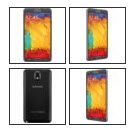
The mobile arena is fierce, and smartphone manufacturers are constantly trying to innovate and bring the next “hot feature” to mobile tech enthusiasts. And while we have seen great strides in new functionality, from the rebirth of the stylus to hyper-resolution camera shots, form hasn’t changed much except screen size, but now at least two phone manufacturers are looking into exploring changing the phone’s shape. Both Samsung and LG are offering devices with dramatic curved displays, but should we care?
While curved displays are nothing new – the Galaxy Nexus was marketed as having a curved screen – previous phones were never as dramatically curved as the upcoming Samsung Galaxy Round or the LG G Flex. The Round offers the same dimensions as the recently released Galaxy Note 3, but without the S-Pen. It also features a significant bend along the lengthwise axis. The idea is to be more comfortable in the hand. The LG G Flex offers a similar curve, but this one runs across the widthwise axis, supposedly matching the contours of the face better for those who don’t use Bluetooth headsets. I applaud both manufacturers for their design aspirations, but I’m not sure either design is practical beyond novelties to show off to friends and family.
Here are the issues I see with curved displays:
Curved Does Not Mean Flexible: These phones are shaped with a bend, but do not actually bend. That means they are permanently frozen in these shapes, making them an awkward proposition in placing them in all the spots we normally jam our cell phones. Imagine the strange bulge these phones will make in pants pockets. How will they fit in all of the other slots we use for phone storage, like in the pockets of our messenger bags?
Fragility: Theoretically, the curve should make these phones sturdier in the way that eggshells can support several times their own weight. On the other hand, however, curved designs create a negative space on either side of the phone. So sitting on them or placing them at the bottom of a book bag may end up putting the phone under stress that only straight phones can survive.
We Consume Media on Flat Displays: With the exception of very large displays like IMAX screens or gigantic desktop monitors, both of which are meant to reach into the viewer’s periphery, whenever we look at screens they are flat. Only in recent years have IPS (in-plane switching) panels come into vogue, which allow for image and color fidelity at wide viewing angles. How are images going to be affected with a curved display? Will the edges look distorted and/or washed out? Will we have to position our eye-line just right to see the images correctly? Can more than one person look at the screen and still see accurate representation?
With that said, I am still excited by this next step in curved displays, because it brings us closer to functional wearable devices. Imagine a smart bracelet with a display that conforms to the shape of your wrist. Or consider a more discreet version of Fallout’s Pipboy running down the length of your forearm. These two models provided by Samsung and LG are still a far cry from something practical, but they are moving in the right direction, and that’s something we should encourage.
Need a new phone?
Check out Newegg’s selection of basic and smartphones.
